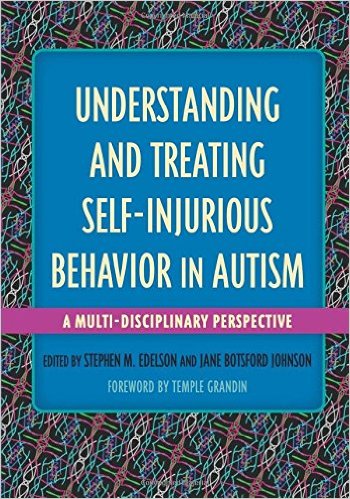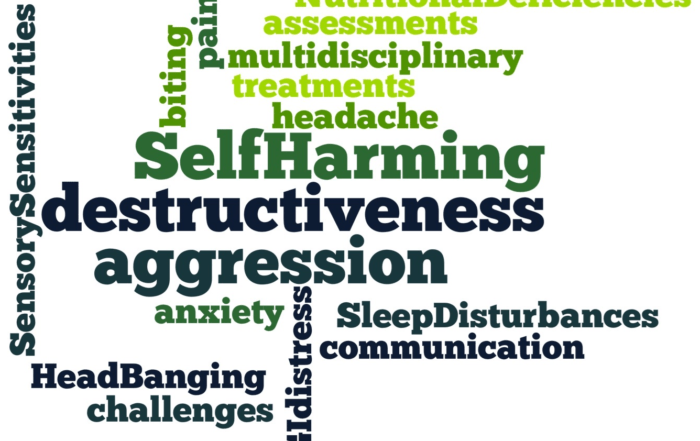 Pictured:
Pictured:
Editors Stephen M. Edelson and Jane Botsford Johnson
On Understanding and Treating Self-Injurious Behavior in ASD
An essential resource for parents, teachers, and health care providers who work with individuals with self-injurious behavior. — Temple Grandin, author of Thinking in Pictures and The Autistic Brain
The root of self-injurious behaviour can be different for each person on the autism spectrum. An individualized approach, considering all options and combinations of treatments, provides the best chance for a healthy and happy life. This book is long overdue. — Laurie Mawlam, Executive Director, Autism Canada
This is a “must read” book for all practitioners who interact with families affected by autism. Many of the authors whom Dr. Edelson has brought together in this impressive volume have dedicated much of their adult lives to the treatment of people with autism, and they know just how devastating and difficult to treat self-injurious behavior can be. While it is important to study the causes of ASD, it is equally important to identify and treat co-occurring conditions that jeopardize the longevity and quality of life of affected individuals. This is an important step in bringing awareness to the larger community about self-injurious behavior as a critical issue in ASD. — David G. Amaral, Ph.D., Research Director, The MIND Institute
Self-injurious behaviors, a not-uncommon family of conditions in autism, vary in severity and are sometimes very damaging to the body. Typically, they are difficult to treat. Understanding and Treating Self-Injurious Behavior in Autism, edited by Dr. Stephen M. Edelson and Jane Botsford Johnson, is an important effort to advance knowledge regarding these poorly understood and challenging behaviors that receive inadequate scholarly attention. In this volume, Edelson and Johnson insightfully bring together experts from diverse clinical and research backgrounds who discuss general medical, neurological, genetic, and pharmacological issues that can contribute to causation of self-injurious behaviors, as well as different therapeutic approaches that may be useful in specific clinical contexts. This work communicates current knowledge regarding self-injurious behaviors and advances our understanding in this important area of medicine. Understanding and Treating Self-Injurious Behavior in Autism is highly recommended for clinicians who care for persons with such behaviors and for researchers interested in learning diverse perspectives on the field. — Marvin Natowicz, MD, PhD, Clinical Geneticist, Clinical Pathologist Pathology & Laboratory Medicine Institute, Cleveland Clinic Cleveland, OH
This immensely valuable book guides us through multiple potential target etiologies of self-injurious behavior for effective treatment. Thoughtfully assembled and edited, it represents a much-needed practical and integrative handbook of use to every practitioner who works with individuals with autism spectrum and related disorders. I whole-heartedly recommend it! — Robert L. Hendren, D.O., Professor of Psychiatry, University of California, San Francisco
Introducing: ARI’s Understanding and Treating Self-Injurious Behavior Tool
This free resource provides deeper insight into understanding and treating self-injurious behavior in autism. It is designed to assist professionals and parents in identifying treatments that may reduce or eliminate self-injurious behaviors (SIB) in clients or children. Filling out the questionnaire may provide insight into one or more possible reasons why an individual engages in SIB. Links to published studies on causes as well as appropriate interventions, are also provided.
Self-Regulation Strategies for Self-Injury
Free webinar at 1 p.m. Eastern time (US), Wednesday, December 4, 2024 About the speaker: Emily Ferguson, Ph.D., is a postdoctoral academic researcher and clinician within Stanford University’s
Understanding and Treating Autism: Book Series
A new book, titled Understanding and Treating Sleep Disturbances in Autism, is now available from Jessica Kingsley Publishers. The book is edited by ARI's executive director, Stephen M. Edelson, and past ARI
Understanding and Treating Self-Injurious Behavior in Autism
Pictured: Editors Stephen M. Edelson and Jane Botsford Johnson A comprehensive, authoritative resource on understanding and resolving self-injurious behavior (SIB) in people with autism and related conditions with contributions by top
Understanding and Treating Anxiety in Autism
Pictured: Editors Stephen M. Edelson and Jane Botsford Johnson Understanding and Treating Anxiety in Autism, is now available from Jessica Kingsley Publishers. The book is edited by ARI's executive director, Stephen M.
Causes and Interventions for Self-Injury in Autism
Strictly speaking, self-injury is not a symptom of autism. However, certain symptoms, situations, and comorbidities related to ASD can lead some people with autism to engage in self-injurious behavior. Treating underlying disorders
Self-Injurious Behavior – Anxiety and OCD
Watch Dr. Moskowitz’s previous talk on positive strategies for addressing anxiety and OCD, HERE References in the playback above include: Three methods of saying "no" without escalating: HERE Treatment when









